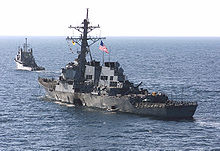- Damage control
-
 Damage control at 9:25AM December 7, 1941: The USS Nevada is shown temporarily beached and burning after being hit by Japanese bombs and torpedoes. A harbor tugboat is alongside, helping to fight fires.
Damage control at 9:25AM December 7, 1941: The USS Nevada is shown temporarily beached and burning after being hit by Japanese bombs and torpedoes. A harbor tugboat is alongside, helping to fight fires.
Damage control is a term used in the Merchant Marine, maritime industry and navies for the emergency control of situations that may hazard the sinking of a ship. It is also used in other contexts as explained below.
Examples are:
- rupture of a pipe or hull especially below the waterline and
- damage from grounding (running aground) or hard berthing against a wharf.
- temporary fixing of bomb or explosive damage.
The term is also used in project management and other contexts to describe the actions needed to deal with any problem that may jeopardize an endeavor. As well, it has been adopted for use in politics and media to describe a need to suppress information or employ spin doctors to represent a response to a situation.
Contents
Measures used
Simple measures may stop flooding, such as:
- locking off the damaged area from other ship's compartments;
- blocking the damaged area by wedging a box around a tear in the ship's hull,
- putting a band of thin sheet steel around a tear in a pipe, bound on by clamps.
More complicated measures may be needed if a repair must take the pressure of the ship moving through the water. For example:
- Thermal lance cutting around the rupture.
- Oxyacetylene welding or electric arc welding of plates over the rupture.
- Quick-drying cement is applied underwater over the rupture.
Damage control training is undertaken by most seafarers, but the engineering staff are most experienced in making lasting repairs.
Damage control is distinct from firefighting. Damage control methods of fighting fire are based on the class of ship and cater to ship specific equipment on board.
Maintenance and drills
In damage control there is more than just the knowledge of the equipment used in a casualty. First you must know how to maintain the equipment used, this is important because the equipment must be in working condition in case of an emergency. For example you must ensure the PHARS (Portable Hydraulic Access Rescue System) is able to do the job you need it to when it needs to be done. You do this by checking the hydraulic fluid and all the connections. Also every month you must ensure the equipment you are performing maintenance on is working. If there were any discrepancies in the equipment you would have to report it and fix it using the proper materials and documents.
Another major part of damage control is drills. On most ships there are four major drills ran depending on the design of the ship. The first type of drill is fire. This is broken down into Alpha fire or anything that would leave an ash, Bravo or any flammable liquid fires, Charlie or electrical fires, and Delta or flammable metals. The second type is flooding drills. These consist of pipe ruptures, hull breaches, or drainage system backups. The third type is toxic gas. This is a big problem on ships as there are many toxic gases on ships and some are more deadly than others. Several examples include H2S hydrogen Sulfide and Chlorofluorocarbon. The fourth type of drill is potentially the most dangerous: a main space fire. This would be a scenario where one of the engines or any auxiliary space for the engine would catch on fire.
Common damage control access equipment includes PHARS (Portable Hydraulic Access Rescue System), PECU (Portable Exothermic Cutting Unit), and hand tools such as axes and mauls.Notable contemporary examples
Particular examples:
- USS Cole: immediate measures to stop sinking after the ship was bombed in 2000.
- USS Samuel B. Roberts: After an Iranian mine holed the frigate beneath the waterline in 1988, the crew fought fire and flooding that threatened to sink it.[1]
- USS Princeton: After an Iraqi naval mine damaged the cruiser during the 1991 Gulf War, her crew fought fires and sealed cracks in the hull, then repaired electronic systems, bringing the Aegis combat system back on line within 2 hours.
- HMS Nottingham: measures to keep the ship afloat after, on 7 July 2002, the Nottingham ran aground on the submerged but well-charted Wolf Rock near Lord Howe Island.
See also
External links
 Media related to Damage control at Wikimedia CommonsCategories:
Media related to Damage control at Wikimedia CommonsCategories:- Nautical terms
- Shipping management
- Military terminology
- Navies
Wikimedia Foundation. 2010.


